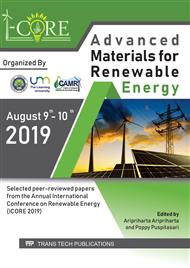[1]
H.W. Chiam, W H. Azmi, N.A. Usri, R. Mamat, and N.M. Adam, Thermal Conductivity and Viscosity of Al2O3 Nanofluids for Different Based Ratio of Water and Ethylene Glycol Mixture,, Exp. Therm. Fluid Sci., (2016).
DOI: 10.1016/j.expthermflusci.2016.09.013
Google Scholar
[2]
A.A. Permanasari, B. S. Kuncara, and P. Puspitasari, Convective heat transfer characteristics of TiO2-EG nanofluid as coolant fluid in heat exchanger Convective Heat Transfer Characteristics of TiO 2 -EG Nanofluid as Coolant Fluid in Heat Exchanger,, AIP Conf. Proc., vol. 2120,05001, no. July, (2019).
DOI: 10.1063/1.5115691
Google Scholar
[3]
H. Wei, X. Nor, A. Che, and S. G. Najafi, Recent state of nanofluid in automobile cooling systems,, J. Therm. Anal. Calorim., vol. 3, (2018).
Google Scholar
[4]
K. Özdemir and E. Öğüt, Hydro-thermal behaviour determination and optimization of fully developed turbulent flow in horizontal concentric annulus with ethylene glycol and water mixture based Al2O3 nanofluids,, Int. Commun. Heat Mass Transf., vol. 109, p.104346, (2019).
DOI: 10.1016/j.icheatmasstransfer.2019.104346
Google Scholar
[5]
Z. Said, M. Ali, H. Rezk, and A. M. Nassef, Fuzzy modeling and optimization for experimental thermophysical properties of water and ethylene glycol mixture for Al 2 O 3 and TiO 2 based nano fl uids,, Powder Technol., vol. 353, p.345–358, (2019).
DOI: 10.1016/j.powtec.2019.05.036
Google Scholar
[6]
W. H. Azmi, N. A. Usri, R. Mamat, K. V Sharma, and M. M. Noor, Force Convection Heat Transfer of Al2O3 Nanofluids for Different Based Ratio of Water:Ethylene Glycol Mixture,, Appl. Therm. Eng., (2016).
DOI: 10.1016/j.applthermaleng.2016.10.135
Google Scholar
[7]
N. A. Usri, W. H. Azmi, R. Mamat, K. A. Hamid, and G. Najafi, Thermal Conductivity Enhancement of Al 2 O 3 Nanofluid in Ethylene Glycol and Water Mixture, vol. 79. Elsevier B.V., (2015).
DOI: 10.1016/j.egypro.2015.11.509
Google Scholar
[8]
M. F. Nabil, W. H. Azmi, K. A. Hamid, R. Mamat, and F. Y. Hagos, An experimental study on the thermal conductivity and dynamic viscosity of TiO 2 -SiO 2 nano fl uids in water : Ethylene glycol mixture,, Int. Commun. Heat Mass Transf., vol. 86, p.181–189, (2017).
DOI: 10.1016/j.icheatmasstransfer.2017.05.024
Google Scholar
[9]
M. Amani, P. Amani, A. Kasaeian, O. Mahian, and S. Wongwises, Thermal conductivity measurement of spinel-type ferrite MnFe2O4 nanofluids in the presence of a uniform magnetic field,, J. Mol. Liq., (2016).
DOI: 10.1016/j.molliq.2016.12.013
Google Scholar
[10]
D. A. Firlianda, A. A. Permanasari, and P. Puspitasari, Heat transfer enhancement using nanofluids ( MnFe2O4-ethylene glycol ) in mini heat exchanger shell and tube Heat Transfer Enhancement using Nanofluids ( MnFe 2 O 4 - Ethylene Glycol ) in Mini Heat Exchanger Shell and Tube,, AIP Conf. Proc., vol. 2120,05001, no. July, (2019).
DOI: 10.1063/1.5115690
Google Scholar
[11]
S.F.A. Talib, W.H. Azmi, I. Zakaria, W. Mohamed, and A.M.I. Mamat, Thermophysical Properties of Silicon Dioxide ( SiO 2 ) in Ethylene Glycol / Water Mixture for Proton Exchange Membrane Fuel Cell Cooling Application, vol. 79. Elsevier B.V., (2015).
DOI: 10.1016/j.egypro.2015.11.504
Google Scholar
[12]
P.C. & M. K. Y. J D Pandey, R Dey, N K Soni, Estimation of thermal conductivity of binary liquid mixtures employing new approach,, Indian J. Chem. Technol., vol. 14, no. November, p.638–641, (2007).
Google Scholar
[13]
T. Bock Choon Pak & Young I. Cho, HYDRODYNAMIC AND HEAT TRANSFER STUDY OF DISPERSED FLUIDS WITH SUBMICRON METALLIC OXIDE,, Exp. Heat Transf. A J. Therm. Energy Gener. , Transp. , Storage , Convers., no. January 2013, p.37–41.
DOI: 10.1080/08916159808946559
Google Scholar
[14]
M. V. * and S. T. K.P. Vasudevan Nambeesan, R. Parthiban, K. Ram Kumar, U.R. Athul and Department, Experimental study of heat transfer enhancement in automobile radiator using Al2O3/water–ethylene glycol nanofluid coolantsK.P. Vasudevan Nambeesan, R. Parthiban, K. Ram Kumar, U.R. Athul, M. Vivek * and S. Thirumalini Department,, Int. J. Automot. Mech. Eng., vol. 12, no. December, p.2857–2865, (2015).
DOI: 10.15282/ijame.12.2015.5.0240
Google Scholar
[15]
I. M. Mahbubul, R. Saidur, and M. A. Amalina, Influence of particle concentration and temperature on thermal conductivity and viscosity of Al2O3 / R141b nanorefrigerant,, Int. Commun. Heat Mass Transf., vol. 43, p.100–104, (2013).
DOI: 10.1016/j.icheatmasstransfer.2013.02.004
Google Scholar
[16]
W. Duangthongsuk and S. Wongwises, International Journal of Heat and Mass Transfer Heat transfer enhancement and pressure drop characteristics of TiO2 – water nanofluid in a double-tube counter flow heat exchanger,, Int. J. Heat Mass Transf., vol. 52, no. 7–8, p.2059–2067, (2009).
DOI: 10.1016/j.ijheatmasstransfer.2008.10.023
Google Scholar
[17]
M. Branch et al., Viscosity of nanofluids: A review of recent experimental studies,, Int. Commun. Heat Mass Transf., (2016).
Google Scholar
[18]
N. Isnaini, FORMULATION AND INVESTIGATION OF ANTIOXIDANT POTENTIAL OF O/W LOTIONS CONTAINING Tamarindus indica L . FRUIT PULP EXTRACT,, MATTER Int. J. Sci. Technol., vol. 5, no. 2, p.100–112, (2019).
Google Scholar


